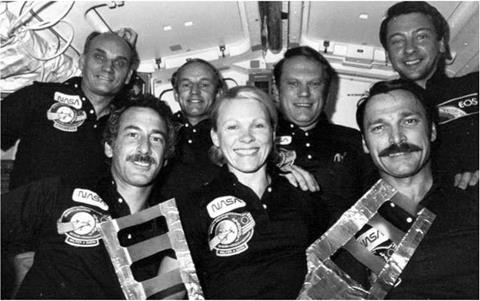STS 51-D
|
Int. Designation |
1985-028A |
|
Launched |
12 April 1985 |
|
Launch Site |
Pad 39A, Kennedy Space Center, Florida |
|
Landed |
19 April 1985 |
|
Landing Site |
Runway 33, Kennedy Space Center, Florida |
|
Launch Vehicle |
OV-103 Discovery/ET-18/SRB BI-018/SSME #1 2109; |
|
#2 2018; #3 2012 |
|
|
Duration |
6 days 23 hrs 55 min 23 sec |
|
Callsign |
Discovery |
|
Objective |
Satellite deployment mission |
Flight Crew
BOBKO, Karol Joseph, 47, USAF, commander, 2nd mission Previous mission: STS-6 (1983)
WILLIAMS, Donald Edward, 42, USN, pilot GRIGGS, Stanley David, civilian, mission specialist 1 HOFFMAN, Jeffrey Alan, 40, civilian, mission specialist 2 SEDDON, Margaret Rhea, 37, civilian, mission specialist 3 GARN, Edwin Jacob “Jake”, 52, US Senator, payload specialist 1 WALKER, Charles David, 36, civilian, payload specialist 2, 2nd mission Previous mission: STS 41-D (1984)
Flight Log
This mission was originally designated STS-14or STS41-F. After the STS 41-D abort, much of the 41-F cargo was incorporated into a new flight attempt and the mission was re-designated as STS 51-E with a TDRS satellite as the primary payload. This flight was to use the original 41-F crew and the orbiter Challenger, plus two unique payload specialists, Frenchman Patrick Baudry and US Senator Jake Garn, the first space passenger-observer. The fated 41-F/51-E mission was again cancelled, this time because a fault was found in the TDRS satellite, due for launch in February. Challenger was rolled back to the VAB to be configured for a later mission, while 51-E and its crew took on the planned 51-D mission mantle, ousting that crew and now assigned both new payloads and a new orbiter, Discovery.
In the ensuing mammoth crew reshuffle for 1985 flights, Baudry was replaced by an original 51-D McDonnell Douglas payload specialist, Charlie Walker, making a unique second space flight. The new launch date was set as 12 April 1985, but when it arrived it was so dark and gloomy that observers were resigned to a launch scrub as the count was inevitably held for 55 minutes, following a short hold due to a stray ship in the SRB splashdown zone. With just 55 seconds of the launch window remaining, the
|
The crew of STS 51-D display the “fly swatter” devices they fabricated to activate the Leasat satellite |
go-ahead was given to proceed with the count, surprising most observers including astronaut John Young, who was reporting rain drops on the window of the Shuttle training aircraft prowling the skies over the launch pad. Discovery disappeared into thick clouds seconds after lifting off in gloom at 08: 59 hrs local time.
The routine deployment of Anik was followed by that of Leasat. Deployment from the payload bay should have activated a spring on the satellite to initiate spin-up and antenna deployment, but clearly this had not happened and yet another Shuttle – deployed satellite was in deep trouble. A contingency EVA was suggested, during which Jeff Hoffman and David Griggs would manually deploy the spring by pulling an arming pin on the side of the satellite while Discovery performed an extremely close station-keeping manoeuvre. This was deemed far too risky and instead the crew manufactured a “fly swatter” device using on-board materials, which could be placed on the end of the RMS during an EVA so that the robot arm could pull the pin.
Hoffmann (EV1) and Griggs (EV2) did their job during a 3 hour 10 minute EVA on 16 April, and it was left to Rhea Seddon operating the RMS to try to pull the pin on Leasat as Discovery closed in. The attempt was useless and Leasat was left stranded. Observers noted that Jake Garn was missing from most of the in-flight TV broadcast and assumed correctly that the senator was having a rather uncomfortable time in the mid-deck getting used to weightlessness. His payload specialist colleague, Charlie Walker, busied himself operating CFES for a second time.
Discovery made the fourth consecutive landing at the Kennedy Space Center on runway 33 at T + 6 days 23 hours 55 minutes 23 seconds, damaging its brakes and bursting a tyre as commander Karol Bobko tried to compensate for crosswinds. Maximum altitude of the 28° orbit was 401 km (249 miles).
Milestones
104th manned space flight
47th US manned space flight
16th Shuttle mission
4th flight of Discovery
1st flight with unscheduled EVA
1st flight of a political observer
1st re-flight of a payload specialist
21st US and 30th flight with EVA operations











